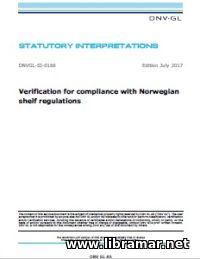 The present DNV-GL specification has been divided by the authors into three major chapters. The first chapter provides general info about services offered by DNV-GL class society and relating to the operation of the vessels on the NCS, standing for the Norwegian Continental Shelf; the second chapter of the specification gives the relevant technical design/construction requirements that would apply at the stage of new construction.
Finally, the last chapter provides the requirements for proper maintenance of NCS-related classification notations in the phase of operation. The document covers all NCS related classification services for the such types of offshore facilities as drilling units, storage units, production units, (and their combinations), well intervention and accommodation units; in addition, following types of installed facilities are covered - production plants, well intervention plants, drilling plants, helidecks and cranes. All technical requirements relating to the design and construction, that are provided in the present document, shall be used as a supplement to the relevant Class Requirements of DNV-GL.
The methodology of verification described in the present specification would be applicable to the offshore units that fully satisfy the following criteria - being DNV-GL-classed with the minimum classification notation "Drilling Unit" or "Enhanced System", and/or registered with a national maritime administration. The units and installations that were verified to comply with the relevant requirements of the document may be assigned the "Drilling Unit (N)" class notation.
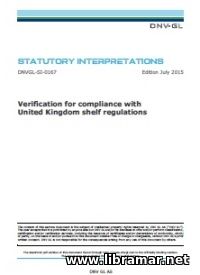 The present DNV-GL OSS provides a general statement of the services offered by DNV-GL classification societies, one of the world leaders in this fiels, relating to the core compliance matters for vessel and offshore installations owners/operators proposed for entering and operation in UK waters.
The UK regulations SCR and PFEER require that all major accident hazards pertaining to an offshore installation are identified and adequately managed throughout the installation lifecycle. This is achieved by a combination of assessing and verifying an acceptable standard of integrity of the installation, safety of operation and protection of personnel. The regulations establish a 'goal setting" (non-prescriptive) approach which enables appropriate effort to be focused on those items which provide the greatest contribution to safety.
The principal aims of the present regulations are to identify all credible hazards that are directly relating to an installation, and eliminate hazards through design where it is possible, assess and reduce rpossible isks from major accident hazards to a level that is as low as reasonably practicable (ALARP), identify, implement and maintain an appropriate combination of inherent safe design, prevention, detection, as well as control and mitigation measures, for the management of these risks throughout the working life of the installation, ensure that systems and equipment for personnel protection in an emergency are suitable and capable of responding to all foreseeable safety-related incidents, ensure that above stated measures are undertaken by competent people understanding the significance of the systems in the management of hazards and possible escalating events, assess changes to the installation which may affect the risks, and revise the systems where necessary to take account of the changes...
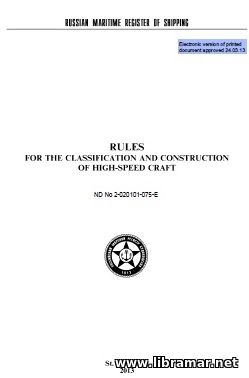 These Rules developed and officially released by Russian register shall apply to passenger vessels regardless of their gross tonnage which don't proceed more than four hour distance from a place of refuge being fully loaded and at operational speed, to cargo vessels of more than 500 GT (eight hour distance, fully loaded, at operational speed), self-propelled vessels other than those specified above with total power output of the main engines being not less than 55 kW.
The Rulebook starts with some general information, including conditions of safety and documentation, followed by chapters addressing the classification process, structure and strength of the hull, arrangements, equipment and outfitting of the high-speed crafts, stability, reserve of buoyancy and subdivision matters, fire protection arrangements, machinery and associated installations, hull systems and piping, boilers, heat exchangers and pressure vessels, electrical installations and equipment, refrigerating plants, construction materials, welding issues, ship automation, life-saving appliances, radio- and navigation equipment, means of signaling, i.e. literally everything related to the design, construction and safe operation of the high-speed crafts.
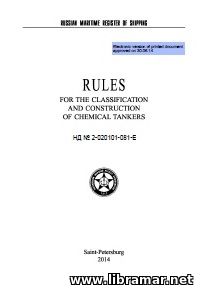 The technical requirements that are contained in the present Chemical Tanker Rules developed and released by Russian register shall be applied to the specially built or converted vessels regardless of their gross tonnage and of any propulsion power, that are intended for carriage of the dangerous chemicals in bulk form.
The opening part of the Rulebook provides us with a brief intro to the structure of the Rules, definitions used and classification notations and surveys. The 2nd part of this Rulebook deals with the hull structure of the chemical tankers while the third one has been dedicated solely to the cargo containment. The subdivision, stability and freeboard assignments are covered in the part four while the part five deals with the fire protection arrangements and systems that are considered critically important due to the dangerous nature of the transported cargo.
The hull systems and piping are there in part six. The other part deals with the electrical installations and equipment. The remaining parts of the book cover instrumentation, construction materials, emergency outfitting, summary of the requirements and some special technical requirements applicable to the chemical tankers. In addition to the information stated above, there are four appendices at the end of the Rulebook, providing the operational requirements, manuals, and other supplementary information that may be required.
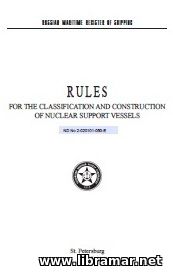 These Russian Register Rules shall apply to self-propelled and non-self-propelled ships involved in the operational support and technical servicing of the nuclear propulsion plants installed on board sea-going vessels and other floating facilities. The Rulebook starts with the brief information on the applicability of the Rules, definitions and explanations; the second part addresses the classification matters, namely applicable classification notations, surveys and technical documentation.
This is all followed by three sections dealing with the hull, subdivision and stability, and some general requirements for nuclear support ships. The chapter on fuel assemblies and storage facilities for the solid waste addresses the new and spent fuel assemblies storage facilities, and facilities intended for the storage of the solid radioactive waste. The chapter dedicated to the special systems covers compressed air and gas systems, ventilation, fuel assemblies handling, special bilge system, systems for the reception of liquid radioactive waste etc.. The two closing chapters of the book deal with the electrical equipment and radiation safety, i.e. radiological protection and radiation monitoring.
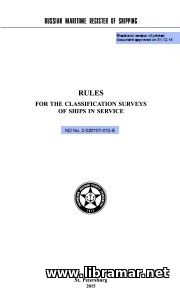 Here are the RS Rules for the Classification Surveys of Ships in Service - developed and officially released by Russian Register, and approved in full accordance with the regular established approval procedure; they are in force since 1 January 2015.
The Rules base on the 2014 edition of Russian Register Rules for the Class Surveys of Ships in Service. In addition to that, all relevant IACS URs, UIs, recommendations and IMO resolutions have been taken into consideration in the Rules. The Rulebook content starts with the general provisions including explanations and definitions, abbreviations, survey types, technical documents, requirements that would be applicable to the service suppliers etc. The next part of the book describes the schedule and scope of the classification surveys. The third part of the document deals with the additional surveys carried out depending on the hull material and purpose of the vessel, while the fourth part covers classification surveys of refrigerating plants.
Three appendices supplementing the main body of the Rules provide the list of technical documentation for the vessel, list of documents recommended for use at the time of the hull repair, and instruction for determining of the technical condition, renovation/repair of the hulls.
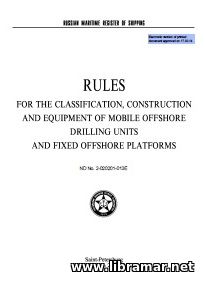 Here are the RMRS Rules released to cover the classification, construction and equipment of MODU/FOP, both non-self-propelled and self-propelled, drillships and any kind of floating platforms. The technical requirements contained in this publication shall apply to all machinery that is installed on board such offshore units, all devices, apparatuses and other equipment, whose normal operating conditions would ensure the required level of safety of the unit/platform as a whole in all operating modes.
All drilling/production equipment and technical solutions related to the safely of drilling and well operations, shall conform with the requirements of state bodies engaged in safety supervision in the offshore industry. The Rulebook has been divided into twenty parts. The first part describes the basics of classification - classes of mobile units, applicable notations, surveys, technical documentation, etc. The second part deals with the hull and describes principles of the structural design, platform-specific strength issues, stability of jack-ups on the seabed etc. The third part covers the equipment, arrangements and outfitting of the offshore units including rudder and steering gear, where applicable, position keeping systems and their components, jacking system, emergency outfit, lifting devices, closing devices etc.
The next two parts address the stability and subdivision, including general requirements, stability criteria and damage trim and stability. Then there is a chapter on structural fire protection, fire detection, alarm and extinguishing systems and equipment and systems. This part is followed by the machinery and associated installations - here you will find the requirements to the main and auxiliary machinery including gas turbines, deck machinery, hydraulic drives etc...
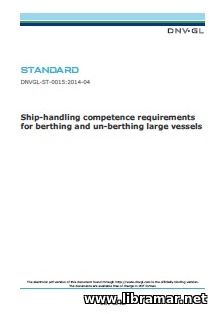 The DNV GL standard dealing with the requirements to the ship-handling competence for berthing/unberthing large ships. It is clear to everyone today that the constantly increasing sizes of the ships, particularly container ships, poses so many new challenges for the officers of the vessels at the time of unberthing and berthing of the ships. The sizes of the vessels in question may exceed 400 meters in length.
In addition to what has been mentioned above, the serious need to maintain slow-speed control of these huge ships under different environmental conditions impose additional number of skills on the officers. The present standard is mainly intended to address all special competencies required by the officers responsible for berthing/unberthing large ships having specific manoeuvring characteristics. Please note, however, that the other competences such as port approach and anchoring are not considered part of the scope of the present document.
The ship's officers who are responsible for the operations dealt with in this standard must at all time be able and ready to take command of the vessel, operate the controls for the propellers/thrusters/rudders, and use tugs in any weather condition. In short, the standard describes what and how the ship's officers must do during the berthing and unberthing of the large vessels.
« 1 2 ... 17 18 19 20 21 ... 29 30 » |







